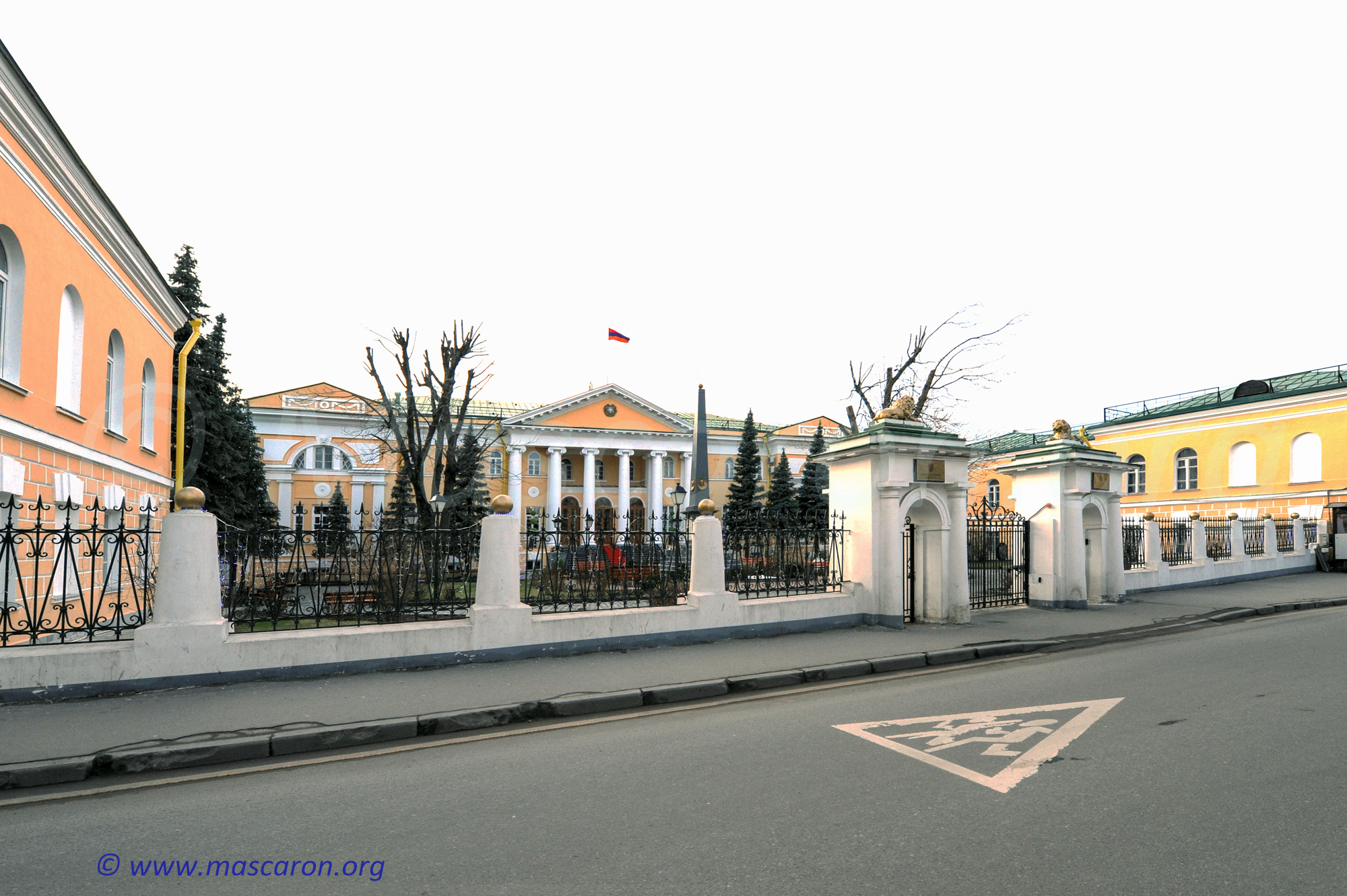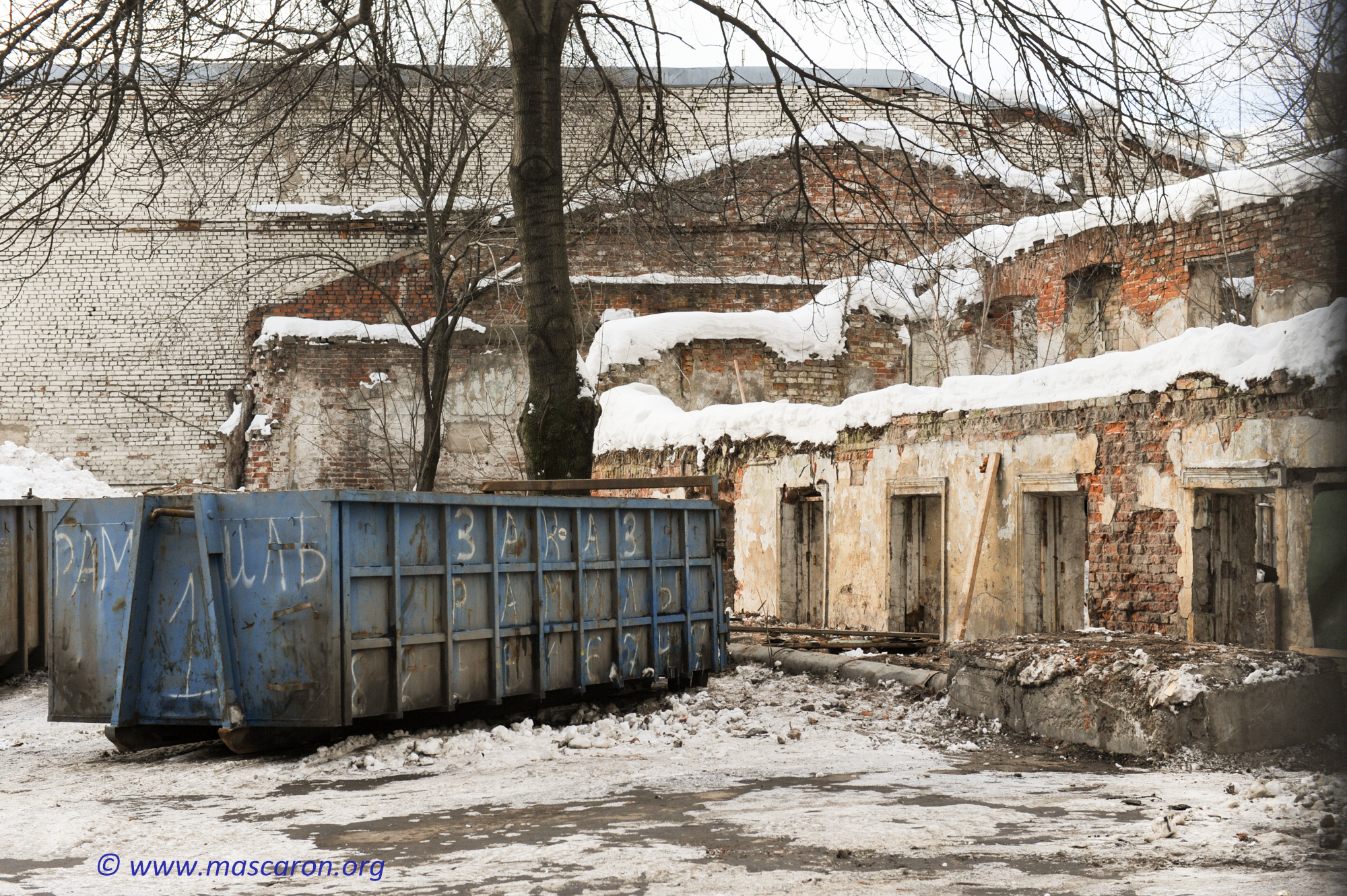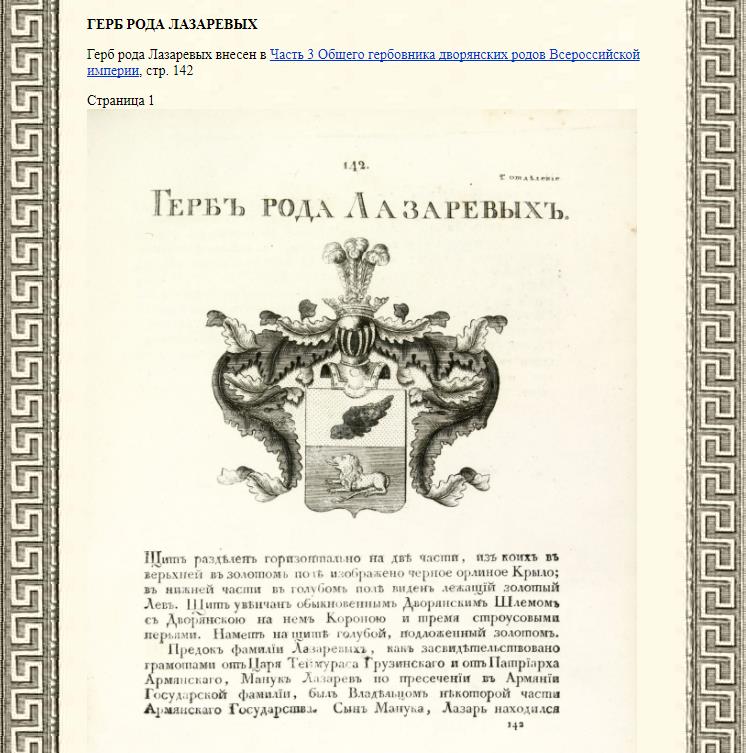Armenian diamond «Graf Orlov»
(from «The Moscow Lions» review)
Two lions placed on the pylons of the gates of the Lazarev Institute in the Armenian side-street (# 2) — old manor, survived the fire of 1812, for two hundred years now have been watching to all those are entering in. They are clearly not asleep, and their only seemingly serene, seemingly pose, leaves no doubt that they have something to guard here. And this is not only a miraculously preserved example of Moscow’s manor development, dating back to the 17th century, but also a mystery connected with the place itself and its owners.
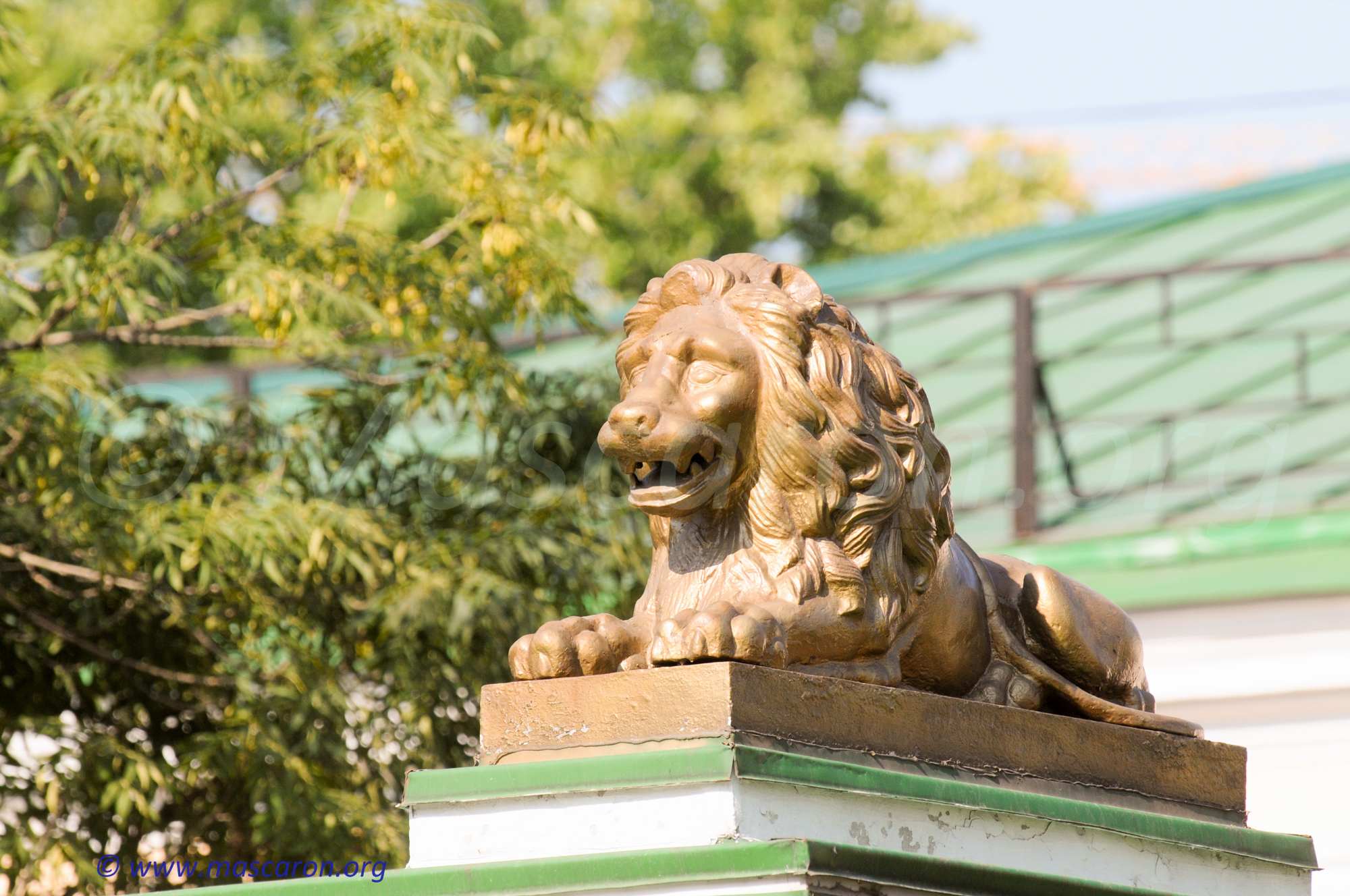 |
 |
«Great Mongol», and even earlier «Lunar (or yellow) diamond», and perhaps also «Durianur» (which means «sea of light» or «Sea of sunlight» — the original Indian name) … that’s how many different, by its remarkable naming, is attributed to only one stone. But to what! Diamond weight (in the current state after cutting) 189.62 carats! Who has not heard about the famous diamond «The “Orlov Diamond» which adorns the scepter of Russian Autocrats. Yes, yes it is this «our» » Orlov Diamond » before its appearance in Russia bore such names. The history of this diamond, however, like much associated with precious stones is shrouded in secrets. This stone became the «hero» of many adventures that left a “visible trace” somewhere, but somewhere just vague hints and riddles.
But «the case, the god inventor» has left a place for Moscow in the way of the history of the adventures of this diamond. And this is not only the Diamond Fund of the Moscow Kremlin itself, where the Scepter of Russian Autocrats with this diamond is being kept, but also the seemingly quiet, cozy and distant «from power» Moscow lane in Myasnitskaya part — Armenian Lane. And earlier — Stolpovsky (or Nikolsky) lane by the name of the church (St. Nicholas in the pillars and Semion Stylites). More precisely, the story of earl Orlov and the stone and the earl itself is inextricably linked to the building 2 along the Armenian lane. Now the Embassy of the Republic of Armenia is placed here. And actually it is a property of Armenia. Amazing ! — an object of cultural heritage of Russia! The amazing fate of the object of Russia’s cultural heritage!
About this wonderful possession, and the secrets that enveloped its owners like a ghostly veil that hides the riddles of the origin of the financial capital and the history of entry into the «higher world,» and will go below speech.
In 1758, wealthy merchant of Armenian origin, who moved from Astrakhan to Moscow, Lazar Nazarovich Lazaryan, bought the property in Stolpovo with two floors stone buildings. The owner and seller of this property was Zachary Sharimanyan (Sheriman, Shahriman, Sharimyan, Shahrimanian, Seriman) another representative of the Armenian Diaspora in Moscow, was not yet so numerous. It is noteworthy (is it an accidental coincidence only?) Is the fact that both families come from one Armenian suburb of the former capital of present-day Iran, in the past of Persia — New Julfa (Isfahan). Various Armenian printed sources note the great financial wealth of the Sherimanian family. They also note their business ties connected practically all over the world — Burma, England, Holland, Italy. A 1699 Austrian Archduke (1657), Holy Roman Emperor (since 1658) Leopold I of Habsburg granted them the title of Count for his services in the spread of Catholicism! in Iran. It was the genus of Sherimanianov who headed the Armenian Catholic community in Iran. Khoja Zahar (Zachary) Sagramov (another family name of the Sherimanian family) being in the 1660s the Persian ambassador at the court of Tsar Alexei Mikhailovich did much to develop relations not only of Persia, but of Armenian merchants in Russia. It is believed that it was Khodja Zakhar Sadradova who in the 17th century laid the foundations that have survived to this day, the penetration of Armenian capital into the Russian economy. By the way, it were Khodja Sagradov with his partner Grigor Lusikovoff who brought the famous diamond throne, which is stored in the Faceted Chamber of the Kremlin, on behalf of the Persian Shah Alexei Mikhailovich. Here is what the chronicle mentions were preserved: «1660, the Great Sovereign Tsar Alexei Mikhailovich was struck by the whip of Kizilbashskoy Shahov’s blessed man Modevletov, the merchant Armenian Zakharey Saradarov in the gifts: the cross was decorated with gold with stones, with diamonds and with jacinth and pearls, valuation of 22,591 rubles. Altyn. »
In the early 18th century, the Sherimanian family, in addition to several sites with buildings in Moscow, owned and silk manufactory in the present Fryanovo, and even before the official proclamation of St. Petersburg capital built several shopping store there. However, with the accession of Anna Ioannovna, having lost high-ranking protection of of Volynsky family, Sherimanians curtail their activities in Russia and move to Europe. It was at this time (1758) that they sold their «assets» (in Moscow, St. Petersburg, Fryanovo) to the Lazarians, who were destined to continue strengthening the role of the Armenian diaspora in Moscow and Russia as a whole.
Over time, the Lazarian family, in front of their new mansion in Stolpos, builds the Armenian Church (only the almost completely reconstructed house of the parable survived), and in its own possession — in the right wing — opens the Armenian school in 1815. It received the official name — Lazarevsky Institute of Oriental Languages. And behind the lane the stable name Armenian was fixed.
As for the very possession of #2 along the Armenian lane, it acquired the form that has survived to us as a result of two reconstructions. The first, executed in 1814-1823, gave to the central building of the manor and two wings the Empire style, characteristic for the post-fire Moscow view. The author of this project is not exactly known, but there are still references to the fact that the construction was supervised by T.G. Prostakov with the participation of the serf architect I. Lazarev. Podyacheva. The Obelisk of Lazarev (established in 1822) was at that time behind the main building in the manor park, and was moved to the central line of the main entrance only in 1914.
But the iron lions decorating the pylons of the front gate still carry their guard duty. However, we must not forget that on the coat of arms of the Lazarevs (nobility was granted to them by Empress Catherine II in 1774) there is a lion. Therefore, the appearance of a lion, albeit not in an explicit, coat of arms, is nevertheless called to serve as a reminder of the aristocratic family that owns this mansion.
Apparently, to give importance to the forests during the regular reconstruction of these cast-iron lions, they were «gilded.» It is not right to say that these are exactly the iron lions, it’s impossible to check their cast-iron nature, but the general view of them, as far as one can judge, is exactly the same as in the lithographs of the first half of the 19th century.
On the lithography (watercolor) of 1836, made in Paris, you can clearly see and imagine what the manor and the Lazarevsky Institute looked like after the work of I.M. Podyacheva.
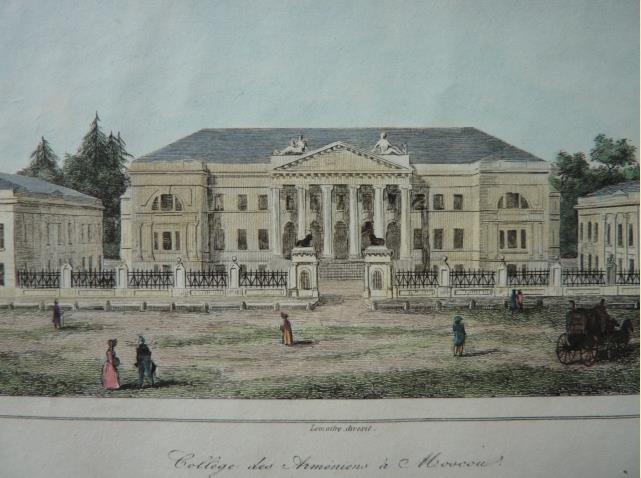 |
 |
In the 1840s, the architect A.G. Grigoriev connected the side wings with the main building with transitions. Later, in 1850, the neighboring chambers of the middle of the 18th century, which had been purchased earlier, were rebuilt and joined to the northern (right) wing.
By themselves, these chambers are noteworthy for the history of Moscow. Like many others, these chambers built in stone back in the 17th century passed to many owners. So Miloslavskiy Larion Semenovich, Prince Peter Alexandrovich Yusupov (?), Pakitan Vasily Priklonsky, Artsebashevs owned the chambers in the Armenian side-street (and also a separate building placed at the Krivokolenny lane). Then, in the 1730s, the owners of this site became merchants of Dutch origin, the brothers Möller. For a short time the owners were Nevsitskie (on the female line — Veshnyakova, daughter, as they say, a major diplomat of the early 18th century Alexei Andreyevich Veshnyakov). But Lazarian bought these possessions from M.A. Saltykovoy. Exactly so far it was not possible to confirm, but there are reasons to believe that this is the Princess Maria Alexandrovna Pototskaya, who was born Saltykova (1807-1845), proceeding in the same way as Veshnyakova, from the genus of diplomat A.N. Saltykov. If this assumption is true, then the portrait of the owner of this estate can be found in the portrait gallery of Orest Kiprensky. And among her “circle” of contacts were Zhukovsky and Vyazemsky.
After the accession of these 17th-century chambers to the main building of Lazarev’s manor they housed the so-called Printing House.
During the restoration work of recent years, the old brickwork, typical of the 18th century, has been partly uncovered (recreated). But unfortunately the fate of another ancient building, also located on the territory of the Armenian embassy — causes obvious fear for their safety — are the ruined fragments of the Nesvitsky’s mansion (probably Miloslavskys?). It’s wanted to believe that the Republic of Armenia will take care of this as carefully as it does to the main building of the Lazarev Institute itself.
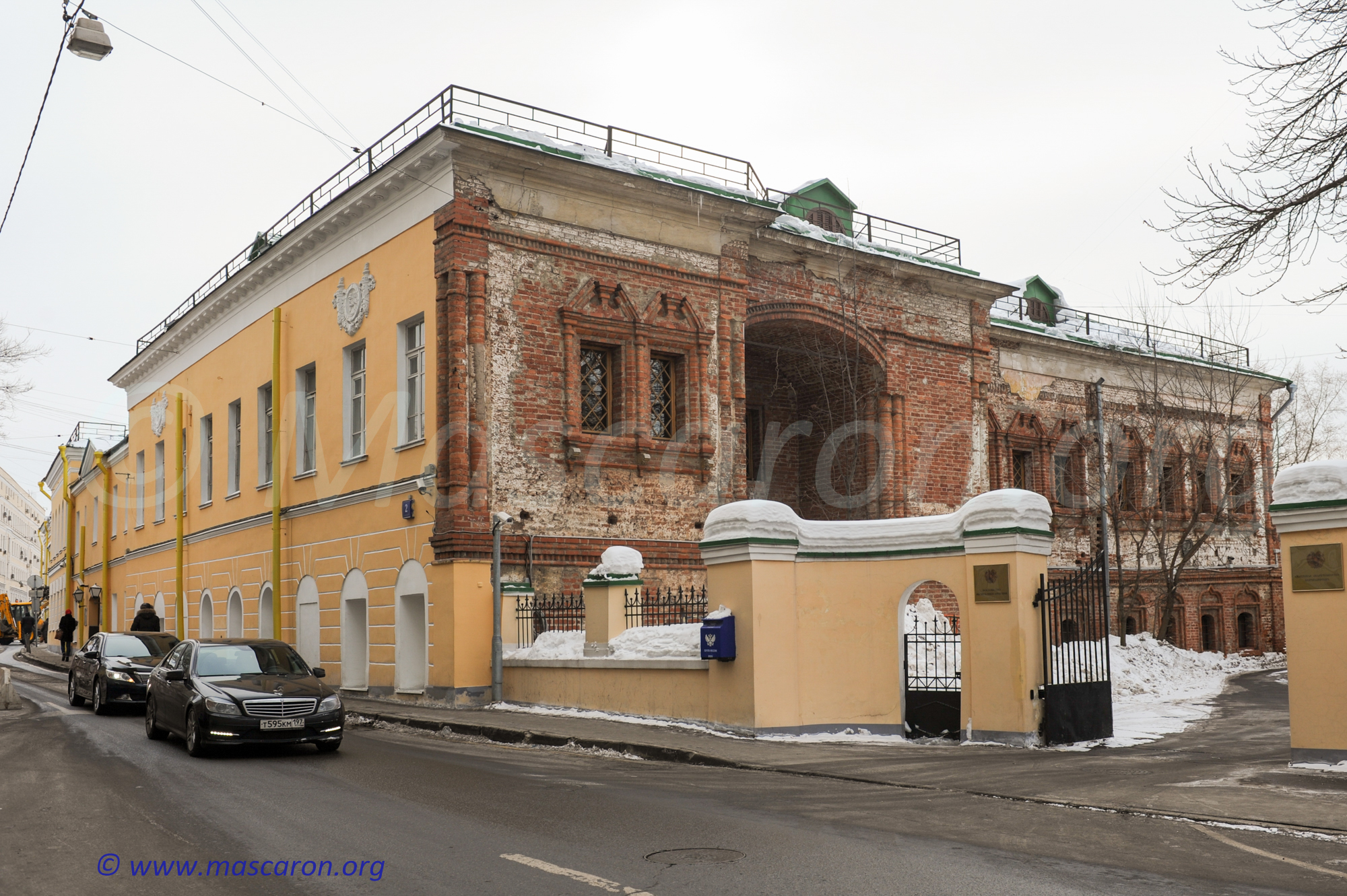 |
 |
Ruined chambers of Nesvicki
The facade of the main building of the manor and its outbuildings is decorated with typical masks of lions (http://mascaron.org/?pid=875) and a medallion with three faces accompanied by torches of enlightenment (http://mascaron.org/?pid = 2218)
Possession 2 on the Armenian lane survived and has survived to the present day. It contains not only an interesting architectural and artistic heritage, but also a whole layer of legends inherited from its notable owners — the ancient Armenian families Sharimanyan and Lazyaryanov.
By the way, it is thanks to its Armenian «patronage» that the ancient chambers in possession of 2 in the Armenian lane were not damaged during the fire of 1812. Documentary evidence apparently did not remain, but numerous memories that eventually turned into legends, argue that the Armenian community appealed to the personal bodyguard of Napoleon, Mameluke Rustam, asking about the management of protection from a fire. Rustam, being himself Armenian by nationality, could not refuse his fellow tribesmen by blood, and possession survived the Moscow firefighting affair under the supervision of the French troops that seized Moscow. That’s how the solidarity of the Armenians was saved by the current cultural heritage in Moscow, but which the Republic of Armenia began to own!
But there is one more, not even tradition, but the history of this domain, wrapped in the «diamond secret», and Lazaryanov himself. Here is what is written about the origin of the Lazyaryanov family in the «General Gerbovik of the noble families of the All-Russian Empire»: «The ancestor of the Lazarev family, as evidenced by the letters from Tsar Teymuras of Georgia and from the Armenian Patriarch, Manuk Lazarev on suppressing the State name in Armenia, was the Owner of some part of the Armenian State . The son of Manuk, Lazarus (or Elizar — note www.mascaron.org) was under the second Shah Abasse the Chief Over the Mint Persian court and the treasure-keeper. The grandson of this Lazarus, Lazar Lazarev, when he was in Persia, we use many commissions and was the Chief of the City of Zhulfa; and finally with his children he left for Russia and started a noble Manufactory. In 1774, on May 20, he Lazarev, for the many services rendered to him by the Decree of the blessed and eternal glory of the passive memory of the Empress Ekaterina II, the Most Gracious, was granted to his children and their descendants in the Russian nobles. All of this is written out from the submitted copy of the Diploma, granted in 1776 October 3 day to the aforementioned Lazar Lazarev for noble dignity. »
What should be noted in the context of the «diamond secret»: the grandfather of Lazar Lazaryan, who moved to Russia, was the actual keeper of the treasures of the Iranian Shah. Namely, there, in this treasury of the Iranian Shah, and was located, mounted in the throne, the very huge diamond — «The Orlov Diamond». However, then, for obvious reasons, he could not yet be called earl Orlov.
In the special literature, you can find enough descriptions of the origin of this diamond, up to its mysterious disappearance from the Shah’s throne. There is also no doubt, and it is possible to document the fate of the stone, beginning with the «operation» on its acquisition by Count Orlov.
In the Middle Ages, almost all the most luxurious diamonds were mined on the richest Golconda diamond mines in present-day India. The Golconda fortress, which has survived to this day, was only a market where diamonds were sold and bought. The richest mines, where the largest historical stones were found, were nearby, near the Kistna River. Some studies suggest that our «hero» was a fragment of a large crystal, probably weighing 400 carats, also found in these mines. It is possible that the famous diamond «Shah» (which also now resides in the Diamond Fund) could be a part of this crystal. The original owner of our Stone («Durianura») in the 17th century was the Golconda Raja. The stone was almost immediately attributed various mystical properties, perhaps because of its unique properties — an unusual greenish-yellowish glow especially noticeable in the moonlight. It was believed that the stone possessed a mystical power to carry to the Earth the Cosmic energy, and this force was transferred to the owner of the stone. There are legends that this stone at one time adorned the brow of the Indian god of the moon Chandra (by other — Vishny) and was particularly revered, giving the owner of the stone a mystical undivided power over the world.
Belonged to the beginning of the XVII century to Raja Golconda (at that time an independent territory) diamond «Lunar Diamond» after the conquest of the great Moguls padishah Shah Jahanon (the empire was located on the territory of modern India, Pakistan, Bangladesh) goes into the possession of the ruling Mughal dynasty. So the stone, now bearing the name «Great Mogul», found itself in Delhi.
By this time the first documentary description of the stone also applies. This description was made by the French traveler Jean Baptiste-Tavernier in 1665 during his visit to the treasury of the padishah of the Mughal Empire Aurangzeb. There is no unequivocal opinion regarding the cuting. There is a point of view that have survived the original cuting even the ancient Indian (or rather — Golkondskih) Masters, but there is also an opinion that the stone on behalf of Shah Jahan of the Mughal emperor (his father Aurangzeb, and, by the way, the builder Taj Mahal), an additional cuting could be performed by the Venetian carver Ortenzio Borjo. But, one way or another, the faceting of a stone is recognized by almost everyone as unique and exemplary, maximally preserving and revealing the original forms and properties of the stone. There are names of such cut — «Indian rose» — it has about 180 faces. That description of Jean Baptiste Tavernier (mention a slight incision, and in it a subtle muddy spots on the bottom edge) and allowed Academician Fersman in the 20-ies of XX century to reaffirm the identity of our «The Orlov Diamond», exactly as the «Great Mogul «.
In 1739, the city of Delhi itself, the capital of the Mughal at that time, captured the Nadir Shah. Nadir Shah created a huge empire, which apart from present-day Iran included Armenia, Azerbaijan, Georgia, part of Dagestan and Afghanistan. «Great Mogul» was in the service of Nadir Shah — the diamond was mounted in the back of the Shah’s throne. But not long this magnificent stone had to decorate even the throne, but still after the «third eye» of the moon god, the controversial place assigned to him by the shah — in the back of the throne.
In the early 40-ies of the XVIII century, the empire of Nadir Shah declined. And already from 1745 and for more than 20 years, the documentary «marks» of the diamond itself are completely lost.
Again, documentary evidence appears in 1867 only : a certain Grigory Safras (as the Armenian Encyclopedia of the Hayazg Foundation — Khojaminas Grigory Safrazovich points out the descendant of the famous Khodja Minas family), transfers a huge diamond to the Amsterdam bank of the British East India Company for storage. Amsterdam was already at that time recognized as a diamond exchange. From documents it is known that Grigory Safras was a wealthy merchant, a native of Julfa. And the name of this city was already mentioned above: it was in Djulfa that the birth conditions of Lazaryanov and Shiramanianov were formed.
But not only the place connected Gregory Safras with the Lazyaryans. The nephew of Grigory Safras’s wife was none other than Ivan Lazarev (Lazaryan), the son of Lazar Nazarovich Lazyaryan, who moved from Persia to Russia (recall — Lazar Nazarovich’s grandfather, too, Lazar (Elizar)) «was under the second Shah Abasse chief of the Monetary Persian courtyard and treasure keeper. «)
And it was exactly Ivan Lazaryan who in 1772 carried out a successful deal — he buys and sells the diamond to Count Orlov, who in turn presents the Empress Catherine II as a gift for her name-day.
But in what way after his «service» to several regal dynasties, this amazing diamond was found by Grigory Safras? In the literature on stones, you can find different versions, one more mysterious than the other. But here is what the publication «Brotherly Aid to Turks Affected in Turkey» says in 1897: «Lazar Lazarev had jewelry trade in Moscow, and he owned the world’s best «Orlov» diamond (185 carats), presented by Count Orlov to Catherine II and now decorating the Russian imperial scepter. There are several legends about this diamond. They say that Lazarev, covering his treasure from the Persian shah, made himself an incision on his thigh and hid him there. Orlov paid Lazarev 450 thousand rubles (according to other sources — 400 thousand, note www.mascaron.org) and 2 thousand rent, now he is valued over 2 million. »
Remembering the family ties of Grigory Safras and Ivan Lazarev, and the general origin of their genera Djulfa, with a fairly high degree of probability, we can assume exactly how the diamond turned out to be for Lazarians, and then for Safras. It is noteworthy that it was by mutual agreement of Grigory Safras and Ivan Lazaryan that a unique diamond, most likely secretly exported by Lazar Lazarian from Persia, was placed in the Amsterdam bank. Most likely, in order not to “wake a sleeping dog”, in Amsterdam, the diamond already appears as the property of Gregory Safras. Confirmation of this kind of «partnership» from the very beginning of the «operation» on the official acquisition of a diamond can partly serve as the text of Ivan Lazarev’s petition filed in 1779 concerning the division of the property of the deceased Grigory Safras: «In 1772 October 20, Grigory Safras of his one hundred ninety-five carat diamond a half share, sold me for 125,000 rubles … so that I try to sell to the common account and at a cost that in the proceeds will be equal to half us to divide, as in 1774 the aforementioned diamond and sold from me to the lighter mu Prince Orlov, in seven-year terms, for 400,000 rubles). And before the sale of the stone and for five years at the expense of trying to sell this stone, the expenditure was 11,800 rubles. »
Many rumors were circulating about the sale of the stone to Count Orlov, but many documents were unexpectedly «lost,» as evidenced, in particular, by Gavriil Romanovich Derzhavin. He retained memories that allegedly the former director of the Imperial Secret Chancer, had kidnapped and destroyed (?) Documents about the sale of a diamond by Ivan Lazarev. Allegedly these documents contained discrediting business reputation about the fraud of the Lazarevs, thanks to which they took possession of the diamond. According to one information Ivan Lazarev was a jeweler of the Empress, according to other sources, Graf Orlov himself played only the role of «cover», and the sum of 400 000 rubles — at that time very significant — was singled out by the Empress herself …. Questions and puzzles only multiply.
But, one way or another, already in 1874 Catherine II granted Lazarev a hereditary nobility, and Ivan Lazarev permanently and firmly strengthened in the «highest» light at the Court. And the amount of 400 000 rubles is beyond doubt ….
At the bequeathed in 1800 by Ivan Lazarev 200 thousand rubles banknotes his heirs and was in 1814-1823 built (converted) complex «Lazarevsky Institute», where the lions are adorned on the pylons of the gate.
It is possible that these lions, in addition to their decorative purpose, as well as the coat of arms of the noble family of Lazarevs, guard this mystery of the appearance of the diamond «The Earl of the Eagles» in Russia. Perhaps, therefore, it is not accidental that the object of cultural heritage of federal significance — a monument of the history and culture of the peoples of the Russian Federation — is in the ownership of the Republic of Armenia.
